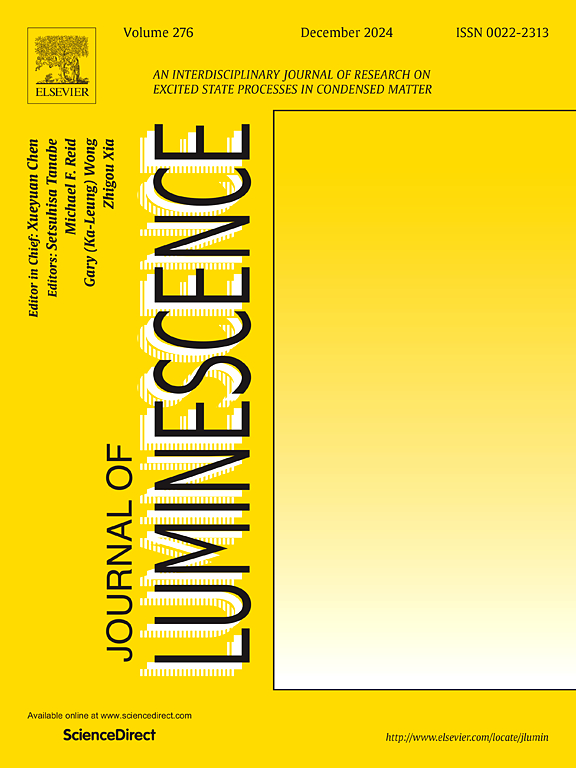电解质辅助硅半导体中基于Bi3+活化的正磷酸盐薄膜的紫外- c发射装置
IF 3.3
3区 物理与天体物理
Q2 OPTICS
引用次数: 0
摘要
电解质辅助半导体作为一种创新类别和现代电子发展的有前途的候选者,已经引起了人们的极大兴趣。在此,我们提出了一种基于电解质辅助半导体的光电器件,即所谓的电解质辅助电致发光(EEL),具有Bi3+活化的正磷酸盐薄膜的紫外-c (UVC)发射。该方法中的电解液作为正弦波源运行过程中电化学反应产生的载流子传递层。通过将Bi3+离子加入到正磷酸镧薄膜(YPO4和LuPO4)中,观察到在251 nm处的UVC发射峰,这归因于Bi3+在宿主晶格内的电子跃迁。与传统的EEL设备相比,我们的EEL设备在更低的电压和频率(30 V, 50 Hz)下工作,减少了电源的负载。此外,它表现出良好的可靠性,在没有任何封装的情况下,连续运行20分钟后保持其排放强度的50%。此外,与其他UVC源相比,我们的EEL设备具有低成本制造工艺和无汞等优势。因此,这种方法可以进一步扩大发射UVC用于灭菌技术的电解质基半导体的实际应用。本文章由计算机程序翻译,如有差异,请以英文原文为准。
Ultraviolet-C emitting device based on Bi3+-activated orthophosphate films in electrolyte-assisted silicon semiconductor
Electrolyte-assisted semiconductors have garnered significant interest as an innovative category and promising candidates for the development of modern electronics. Herein, we propose an optoelectronic device based on an electrolyte-assisted semiconductor, so-called electrolyte-assisted electroluminescence (EEL) with ultraviolet-C (UVC) emission from Bi3+-activated orthophosphate films. The electrolyte in this approach acts as the carrier transfer layer generated from the electrochemical reaction during the sinusoidal source operation. By incorporating Bi3+ ions into lanthanum orthophosphate films (YPO4 and LuPO4), a UVC emission peaking at 251 nm is observed, attributed to electronic transitions of Bi3+ within the host lattices. Compared to traditional EL devices, our EEL device operates at a lower voltage and frequency (30 V, 50 Hz), reducing the load on electrical sources. Additionally, it demonstrates decent reliability, maintaining 50 % of its emission intensity after 20 min of continuous operation without any encapsulation. Moreover, compared to other UVC sources, our EEL device offers advantages such as a low-cost manufacturing process and being mercury-free. Thus, this approach could further expand the practical application of the electrolyte-based semiconductor that emits UVC for sterilization technology.
求助全文
通过发布文献求助,成功后即可免费获取论文全文。
去求助
来源期刊

Journal of Luminescence
物理-光学
CiteScore
6.70
自引率
13.90%
发文量
850
审稿时长
3.8 months
期刊介绍:
The purpose of the Journal of Luminescence is to provide a means of communication between scientists in different disciplines who share a common interest in the electronic excited states of molecular, ionic and covalent systems, whether crystalline, amorphous, or liquid.
We invite original papers and reviews on such subjects as: exciton and polariton dynamics, dynamics of localized excited states, energy and charge transport in ordered and disordered systems, radiative and non-radiative recombination, relaxation processes, vibronic interactions in electronic excited states, photochemistry in condensed systems, excited state resonance, double resonance, spin dynamics, selective excitation spectroscopy, hole burning, coherent processes in excited states, (e.g. coherent optical transients, photon echoes, transient gratings), multiphoton processes, optical bistability, photochromism, and new techniques for the study of excited states. This list is not intended to be exhaustive. Papers in the traditional areas of optical spectroscopy (absorption, MCD, luminescence, Raman scattering) are welcome. Papers on applications (phosphors, scintillators, electro- and cathodo-luminescence, radiography, bioimaging, solar energy, energy conversion, etc.) are also welcome if they present results of scientific, rather than only technological interest. However, papers containing purely theoretical results, not related to phenomena in the excited states, as well as papers using luminescence spectroscopy to perform routine analytical chemistry or biochemistry procedures, are outside the scope of the journal. Some exceptions will be possible at the discretion of the editors.
 求助内容:
求助内容: 应助结果提醒方式:
应助结果提醒方式:


